Input interpretation

AgNO_3 silver nitrate + LiCl lithium chloride ⟶ AgCl silver chloride + LiNO_3 lithium nitrate
Balanced equation
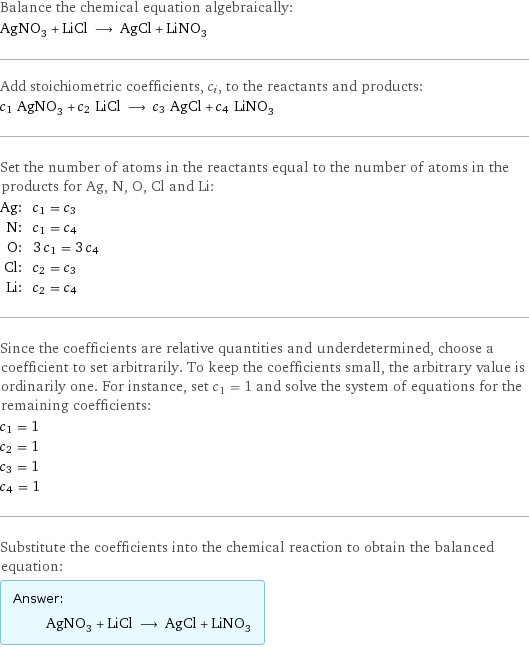
Balance the chemical equation algebraically: AgNO_3 + LiCl ⟶ AgCl + LiNO_3 Add stoichiometric coefficients, c_i, to the reactants and products: c_1 AgNO_3 + c_2 LiCl ⟶ c_3 AgCl + c_4 LiNO_3 Set the number of atoms in the reactants equal to the number of atoms in the products for Ag, N, O, Cl and Li: Ag: | c_1 = c_3 N: | c_1 = c_4 O: | 3 c_1 = 3 c_4 Cl: | c_2 = c_3 Li: | c_2 = c_4 Since the coefficients are relative quantities and underdetermined, choose a coefficient to set arbitrarily. To keep the coefficients small, the arbitrary value is ordinarily one. For instance, set c_1 = 1 and solve the system of equations for the remaining coefficients: c_1 = 1 c_2 = 1 c_3 = 1 c_4 = 1 Substitute the coefficients into the chemical reaction to obtain the balanced equation: Answer: | | AgNO_3 + LiCl ⟶ AgCl + LiNO_3
Structures
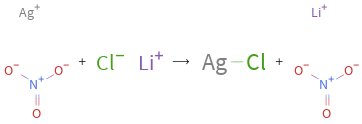
+ ⟶ +
Names

silver nitrate + lithium chloride ⟶ silver chloride + lithium nitrate
Reaction thermodynamics
Enthalpy
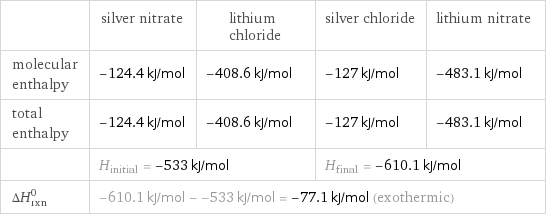
| silver nitrate | lithium chloride | silver chloride | lithium nitrate molecular enthalpy | -124.4 kJ/mol | -408.6 kJ/mol | -127 kJ/mol | -483.1 kJ/mol total enthalpy | -124.4 kJ/mol | -408.6 kJ/mol | -127 kJ/mol | -483.1 kJ/mol | H_initial = -533 kJ/mol | | H_final = -610.1 kJ/mol | ΔH_rxn^0 | -610.1 kJ/mol - -533 kJ/mol = -77.1 kJ/mol (exothermic) | | |
Gibbs free energy
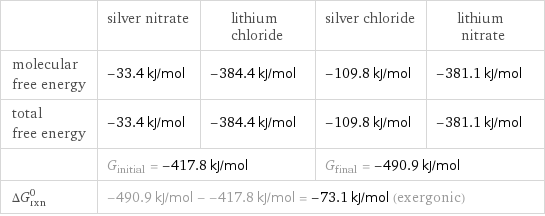
| silver nitrate | lithium chloride | silver chloride | lithium nitrate molecular free energy | -33.4 kJ/mol | -384.4 kJ/mol | -109.8 kJ/mol | -381.1 kJ/mol total free energy | -33.4 kJ/mol | -384.4 kJ/mol | -109.8 kJ/mol | -381.1 kJ/mol | G_initial = -417.8 kJ/mol | | G_final = -490.9 kJ/mol | ΔG_rxn^0 | -490.9 kJ/mol - -417.8 kJ/mol = -73.1 kJ/mol (exergonic) | | |
Equilibrium constant
![Construct the equilibrium constant, K, expression for: AgNO_3 + LiCl ⟶ AgCl + LiNO_3 Plan: • Balance the chemical equation. • Determine the stoichiometric numbers. • Assemble the activity expression for each chemical species. • Use the activity expressions to build the equilibrium constant expression. Write the balanced chemical equation: AgNO_3 + LiCl ⟶ AgCl + LiNO_3 Assign stoichiometric numbers, ν_i, using the stoichiometric coefficients, c_i, from the balanced chemical equation in the following manner: ν_i = -c_i for reactants and ν_i = c_i for products: chemical species | c_i | ν_i AgNO_3 | 1 | -1 LiCl | 1 | -1 AgCl | 1 | 1 LiNO_3 | 1 | 1 Assemble the activity expressions accounting for the state of matter and ν_i: chemical species | c_i | ν_i | activity expression AgNO_3 | 1 | -1 | ([AgNO3])^(-1) LiCl | 1 | -1 | ([LiCl])^(-1) AgCl | 1 | 1 | [AgCl] LiNO_3 | 1 | 1 | [LiNO3] The equilibrium constant symbol in the concentration basis is: K_c Mulitply the activity expressions to arrive at the K_c expression: Answer: | | K_c = ([AgNO3])^(-1) ([LiCl])^(-1) [AgCl] [LiNO3] = ([AgCl] [LiNO3])/([AgNO3] [LiCl])](../image_source/dc79322d16ac11ce71cba5fcb8956d3d.png)
Construct the equilibrium constant, K, expression for: AgNO_3 + LiCl ⟶ AgCl + LiNO_3 Plan: • Balance the chemical equation. • Determine the stoichiometric numbers. • Assemble the activity expression for each chemical species. • Use the activity expressions to build the equilibrium constant expression. Write the balanced chemical equation: AgNO_3 + LiCl ⟶ AgCl + LiNO_3 Assign stoichiometric numbers, ν_i, using the stoichiometric coefficients, c_i, from the balanced chemical equation in the following manner: ν_i = -c_i for reactants and ν_i = c_i for products: chemical species | c_i | ν_i AgNO_3 | 1 | -1 LiCl | 1 | -1 AgCl | 1 | 1 LiNO_3 | 1 | 1 Assemble the activity expressions accounting for the state of matter and ν_i: chemical species | c_i | ν_i | activity expression AgNO_3 | 1 | -1 | ([AgNO3])^(-1) LiCl | 1 | -1 | ([LiCl])^(-1) AgCl | 1 | 1 | [AgCl] LiNO_3 | 1 | 1 | [LiNO3] The equilibrium constant symbol in the concentration basis is: K_c Mulitply the activity expressions to arrive at the K_c expression: Answer: | | K_c = ([AgNO3])^(-1) ([LiCl])^(-1) [AgCl] [LiNO3] = ([AgCl] [LiNO3])/([AgNO3] [LiCl])
Rate of reaction
![Construct the rate of reaction expression for: AgNO_3 + LiCl ⟶ AgCl + LiNO_3 Plan: • Balance the chemical equation. • Determine the stoichiometric numbers. • Assemble the rate term for each chemical species. • Write the rate of reaction expression. Write the balanced chemical equation: AgNO_3 + LiCl ⟶ AgCl + LiNO_3 Assign stoichiometric numbers, ν_i, using the stoichiometric coefficients, c_i, from the balanced chemical equation in the following manner: ν_i = -c_i for reactants and ν_i = c_i for products: chemical species | c_i | ν_i AgNO_3 | 1 | -1 LiCl | 1 | -1 AgCl | 1 | 1 LiNO_3 | 1 | 1 The rate term for each chemical species, B_i, is 1/ν_i(Δ[B_i])/(Δt) where [B_i] is the amount concentration and t is time: chemical species | c_i | ν_i | rate term AgNO_3 | 1 | -1 | -(Δ[AgNO3])/(Δt) LiCl | 1 | -1 | -(Δ[LiCl])/(Δt) AgCl | 1 | 1 | (Δ[AgCl])/(Δt) LiNO_3 | 1 | 1 | (Δ[LiNO3])/(Δt) (for infinitesimal rate of change, replace Δ with d) Set the rate terms equal to each other to arrive at the rate expression: Answer: | | rate = -(Δ[AgNO3])/(Δt) = -(Δ[LiCl])/(Δt) = (Δ[AgCl])/(Δt) = (Δ[LiNO3])/(Δt) (assuming constant volume and no accumulation of intermediates or side products)](../image_source/a42e0ef517f44c8b45f7d46ee398ac2a.png)
Construct the rate of reaction expression for: AgNO_3 + LiCl ⟶ AgCl + LiNO_3 Plan: • Balance the chemical equation. • Determine the stoichiometric numbers. • Assemble the rate term for each chemical species. • Write the rate of reaction expression. Write the balanced chemical equation: AgNO_3 + LiCl ⟶ AgCl + LiNO_3 Assign stoichiometric numbers, ν_i, using the stoichiometric coefficients, c_i, from the balanced chemical equation in the following manner: ν_i = -c_i for reactants and ν_i = c_i for products: chemical species | c_i | ν_i AgNO_3 | 1 | -1 LiCl | 1 | -1 AgCl | 1 | 1 LiNO_3 | 1 | 1 The rate term for each chemical species, B_i, is 1/ν_i(Δ[B_i])/(Δt) where [B_i] is the amount concentration and t is time: chemical species | c_i | ν_i | rate term AgNO_3 | 1 | -1 | -(Δ[AgNO3])/(Δt) LiCl | 1 | -1 | -(Δ[LiCl])/(Δt) AgCl | 1 | 1 | (Δ[AgCl])/(Δt) LiNO_3 | 1 | 1 | (Δ[LiNO3])/(Δt) (for infinitesimal rate of change, replace Δ with d) Set the rate terms equal to each other to arrive at the rate expression: Answer: | | rate = -(Δ[AgNO3])/(Δt) = -(Δ[LiCl])/(Δt) = (Δ[AgCl])/(Δt) = (Δ[LiNO3])/(Δt) (assuming constant volume and no accumulation of intermediates or side products)
Chemical names and formulas
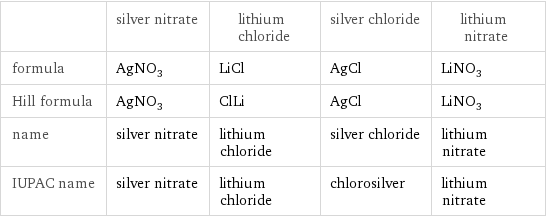
| silver nitrate | lithium chloride | silver chloride | lithium nitrate formula | AgNO_3 | LiCl | AgCl | LiNO_3 Hill formula | AgNO_3 | ClLi | AgCl | LiNO_3 name | silver nitrate | lithium chloride | silver chloride | lithium nitrate IUPAC name | silver nitrate | lithium chloride | chlorosilver | lithium nitrate
Substance properties
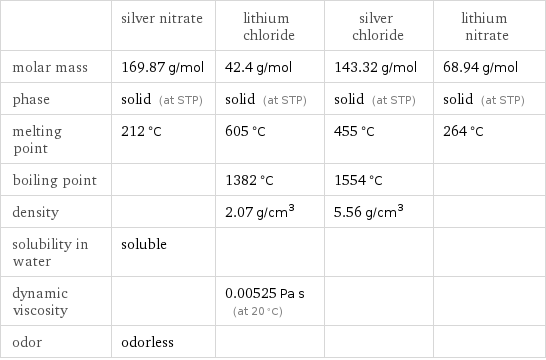
| silver nitrate | lithium chloride | silver chloride | lithium nitrate molar mass | 169.87 g/mol | 42.4 g/mol | 143.32 g/mol | 68.94 g/mol phase | solid (at STP) | solid (at STP) | solid (at STP) | solid (at STP) melting point | 212 °C | 605 °C | 455 °C | 264 °C boiling point | | 1382 °C | 1554 °C | density | | 2.07 g/cm^3 | 5.56 g/cm^3 | solubility in water | soluble | | | dynamic viscosity | | 0.00525 Pa s (at 20 °C) | | odor | odorless | | |
Units
